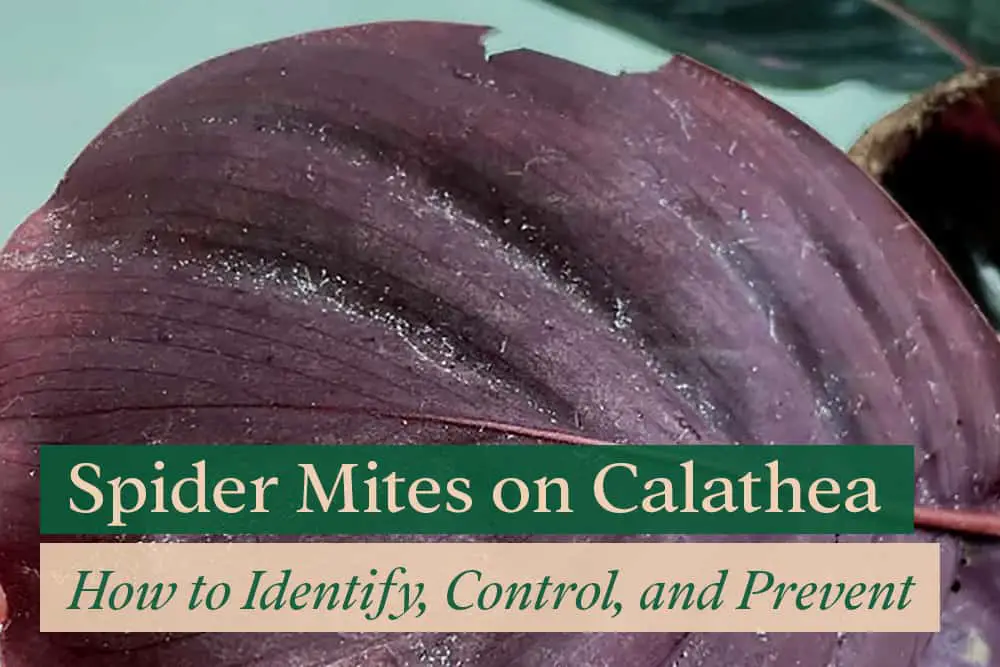
Did you find webbing on your Calathea plants? Are tiny spider-like bugs crawling around on your prized Prayer plant? Those are spider mites!
You can get rid of spider mites on Calathea using insecticidal soap or neem oil. However, you might consider releasing predatory insects such as ladybugs to eradicate these pests for heavy infestation.
This article will help you identify spider mites on Calathea and explain in detail how to save your plant from spider mites infestation. I’ll also go through some preventative measures so that you don’t get attacked by spider mites in the first place.
Let’s get started!
- Things you should know about spider mites
- How to identify spider mites infestation on Calathea
- How to save Calathea from spider mites
- Preventive measures for spider mites infestation
Bloomsprouts may earn an affiliate commission if you purchase something through recommended links.
Things you should know about spider mites.
What do spider mites look like?
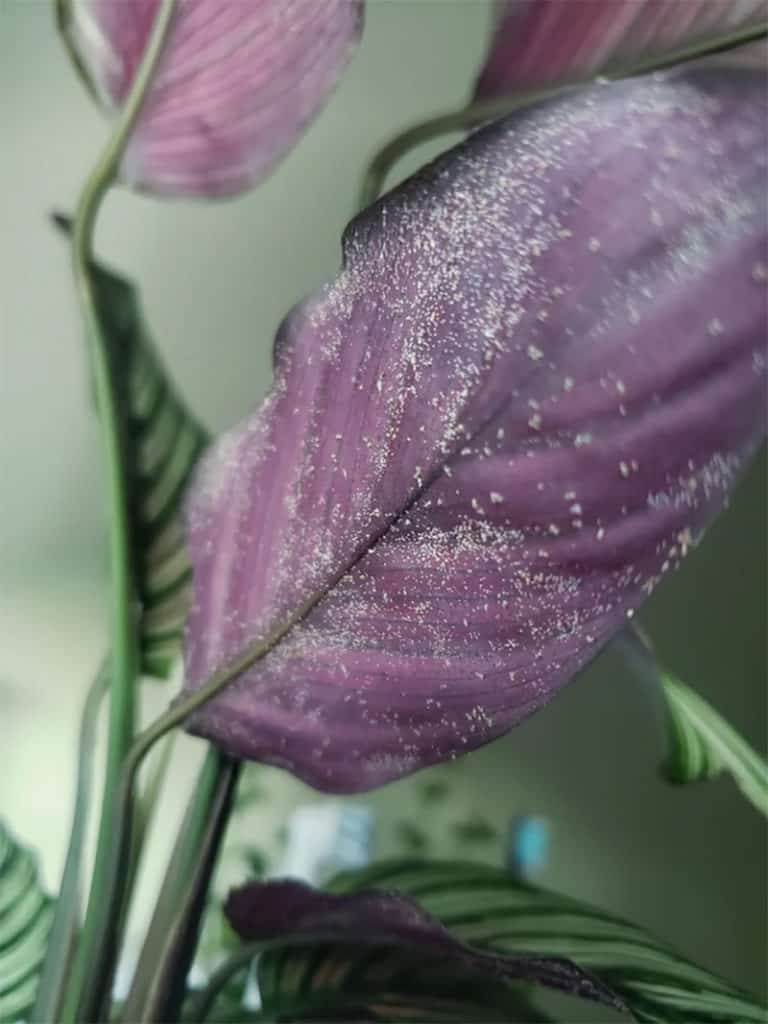
Spider mites are eight-legged relatives of spiders and measure 1/50 of an inch (.51 mm) long or about the size of the period at the end of this sentence.
Even though they’re tiny, they show up fairly easily on plants due to their white or reddish-brown color. Spider mite eggs are invisible to the naked eye, so if you can see the adults, you have an infestation!
Spider mites are one of the most frequent pests of Calathea.
How do spider mites damage Calathea?
Spider mites have piercing-sucking mouthparts that they use to suck the plant juices out of Calathea foliage. They are found mainly on the undersides of the leaves with their white webs that also extend onto the stems.
The life cycle of spider mites
Spider mites go through a five-stage life cycle that lasts between five and twenty days: egg, larva, two nymph stages, and adult.
Small, colorless, larvae hatch from the eggs in about five days and feed on the plant sap. After feeding, they rest on the undersides of the leaves for several days until they molt and become nymphs that look like small, white adults.
They feed and rest again, then go through a second molt as nymphs.
A final feeding and molt bring them to adulthood, where they are ready to breed after five days.
Where do spider mites come from?
Spider mites occur in most temperate and subtropical regions.
They can be blown from place to place via their webbing, or they can hitchhike on infested plants from a store. Spider mites can also travel into or around the house on shoes, clothes, pets, or in unsterile potting mix.
How to identify spider mite infestation on Calathea
Droopy and discoloration of the leaves
When Calathea plants are infested with spider mites, their beautiful leaves become droopy and develop a light-colored stippled discoloration that is easy to identify.
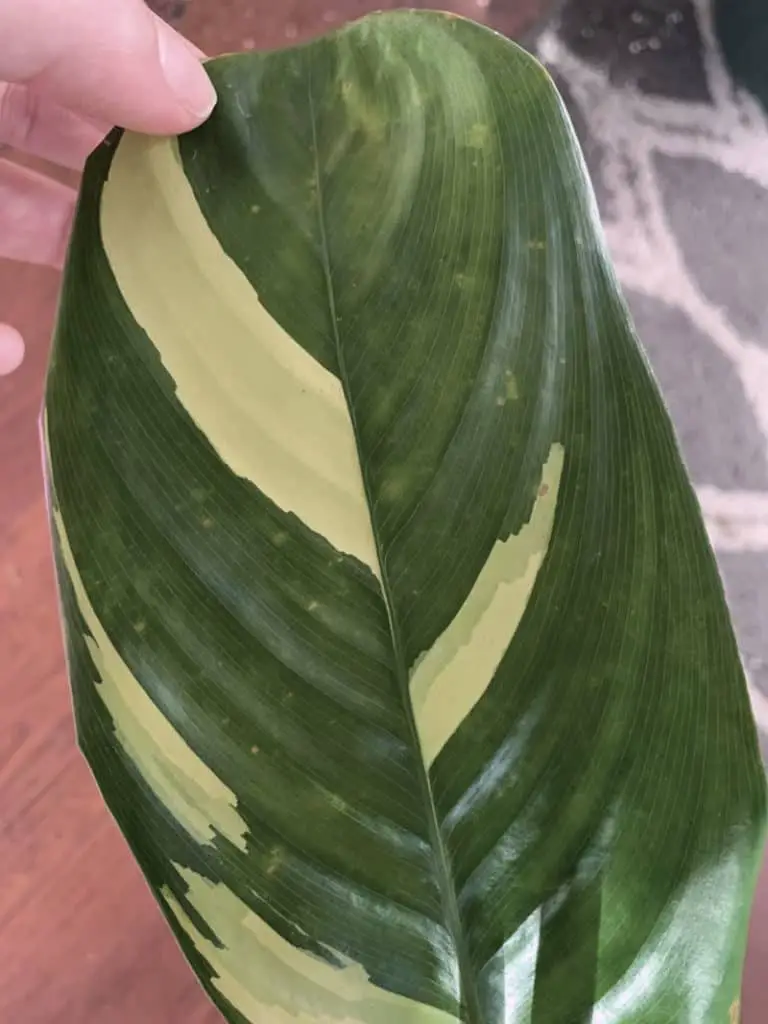
If you see these small, yellowish dots on the leaf tops, be sure to look on the undersides of the leaves for evidence of the mites. Use a magnifying glass to confirm your identification.
Webbings
Mature spider mites spin a white webbing on the stems and undersides of the leaves to protect themselves from predators. This webbing is a distinctive clue that your Calathea plants have an infestation of spider mites.
Calathea leaves not closing at night.
The Prayer Plants move in a day/night cycle where they close their leaves up at night and open them during the day.
There are several reasons why Calathea plants will not close up at night, and an infestation of spider mites is one of those reasons.
The action of spider mites sucking out plant juices damages the mechanism of the plants’ day/night movement cycle.
How to save Calathea from spider mites
Quarantine the infected plant
When you see signs of spider mite infestation on your Calathea, immediately move the plant away from your plant collections and keep it quarantined for 30 days.
Spider mites will travel hungrily from plant to plant and multiply, causing widespread damage.
Once you’ve isolated your infested Calathea, check the other plants for signs of mites as well and isolate them, too, if needed.
Prune the damaged leaves
If there are any dead or damaged leaves, snip them off with a clean, sharp knife or shears since they could be harboring the pests and putting a strain on your plant.
If you see spider mites, their fine webbing, or the stippling damage, cut those leaves off near the node.
Dispose of the dead or infested leaves in a separate, closed bag right in the trash so they are nowhere near your other plants.
Don’t forget to wash your knife or shears thoroughly with soap to eliminate the chance that hitchhiking mites may stray to healthy plants.
Wipe down the leaves and stems
After clipping off the dead leaves, wipe your Calathea down gently with a damp cloth.
A good recipe for a leaf cleaner is one teaspoon of mild liquid soap, such as Castile, to one quart of water.
Wipe the leaves and stems thoroughly, then turn the pot sideways in the sink and rinse the whole plant with warm water so that any pests will wash down the drain and not into the potting mix.
Using insecticidal soap
Insecticidal soap is an efficient way to control spider mites. It is a non-toxic and inexpensive way to get rid of these pests that can be used on Calathea. It works by disrupting the mites’ cellular membranes and suffocating them, killing them quickly.
Both commercial, ready-to-spray insecticidal soaps and dilute liquid soaps are effective. You can make a homemade spray in a clean spray bottle by diluting one tablespoon of mild liquid soap in one quart of water.
Use pure, liquid Castile soap without any additives or perfumes rather than dishwashing liquid. Castile soap will have fatty acids that are necessary to dissolve the mites’ exoskeletons.
Dishwashing liquid doesn’t have fatty acids, so it is not effective against spider mites. It can also be harsh enough to dissolve the natural wax on the surface of the leaves, making them more vulnerable to pests and diseases.
Before you spray the whole plant, test spray a small area of a leaf to make sure it won’t harm the plant, and then wait a day to see the results.
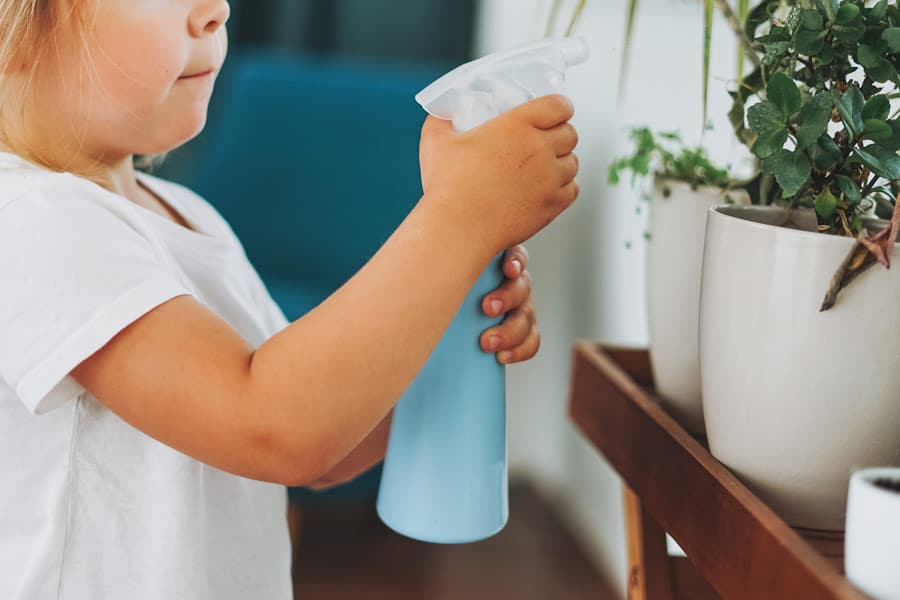
If you see any browning or spotting on the leaf, don’t use it. Either dilute the solution further or use a commercial insecticidal soap.
Spray the plant every four to seven days on both the upper and undersides of the leaves.
The best times of day to spray are in the morning or evening when it is cooler, and the soap is slower to evaporate, since it will only kill mites when it is wet. You can rinse the soap off along with the dead spider mites in a few hours.
Using Neem oil
Neem oil is a natural, organic insecticide, fungicide, and miticide. The oil comes from seeds of the Neem tree (Azadirachta indica) that grows in the tropics and subtropics of India. You can buy it in a ready-to-use spray bottle or as a concentrate that you dilute with water.
Neem oil works by disrupting the mites’ hormone systems so that they will stop eating and reproducing. It takes longer to work than insecticidal soap but is just as effective.
Just like with the soap, test spray a small area on a leaf to make sure it isn’t going to damage the plant and then wait at least a day to see the results.
Do not inhale Neem oil, and use gloves when you spray since it can cause skin irritation in some people.
Spray the upper and lower sides of the leaves where the mites and their eggs are hiding, and keep the plant out of direct sunlight until the leaves are dry.
Spray with Neem oil every seven days for a heavy infestation or every fourteen days for a less severe one. Then rinse the plant off daily to get rid of any lingering mites.
Releasing ladybugs to help rid the Calathea of spider mites
Some people may shudder at the idea of releasing predatory insects in their homes to control houseplant pests, but it is worthwhile if you have a heavy infestation of spider mites.
It is a more complex method of getting rid of the pests than spraying insecticidal soap or Neem oil, but it is also quite effective.
An adult ladybug can eat nine spider mites per hour and up to approximately 100 per day! Below are some things to consider and plan for when using these beneficial insects in your home.
How many ladybugs should I buy?
Ladybugs come in different quantities, but packages of 1,500 are usually enough for an indoor plants garden. You can purchase them at some garden centers and online.
Nourish the ladybugs
They will be dehydrated when they arrive and will need water and food in their bag or container. A piece of damp sponge and some raisins will do nicely.
Create a controlled environment for the release
Ladybugs will congregate on your windows or grow lights in warm temperatures, so it’s best to release them before dawn or after sundown during the coolest part of the day when the light is low.
A small, consistent release on a weekly basis should be enough to decrease the spider mite population.
Place the bag or container of ladybugs near the infested Calathea. The odor of spider mites and the yellowish stippling damage on the leaves will draw ladybugs, so they should be able to zero in on the affected plant.
Spraying the Calathea with water will also attract them and keep them hydrated.
Keeping them off the windows
Your Calathea needs light, and it’s inevitable that even when you release the ladybugs in the cool, darker part of the day, they will be attracted to the light in the windows during the daytime.
When this happens, you can scrape them off with an index card or gently vacuum them up and then empty them into the ladybug bag.
Storing ladybugs
If you need to store them, they will go into hibernation in 35⁰ to 40⁰ F (4⁰ C) but will wake up to hunt spider mites in warmer temperatures. Some experts recommend refrigerating them overnight before a morning release in the warmer months so they will be more likely to crawl and less likely to fly.
A word of caution: If you’ve used chemical insecticides on your plants, the residue may still be on your plants which would kill the ladybugs.
In addition, don’t use insecticidal soap or Neem oil at the same time as releasing ladybugs, or they will die.
Preventative Measures for a Spider Mites Infestation
Isolating new plants
When you bring your new prize Calathea home from the store, it’s wise to isolate it for 30 days from your other plants.
This will give any pests enough time to go through a life cycle and show themselves, and give you time to inspect it for any pests before allowing it to join its household plant companions.
Regularly cleaning the leaves.
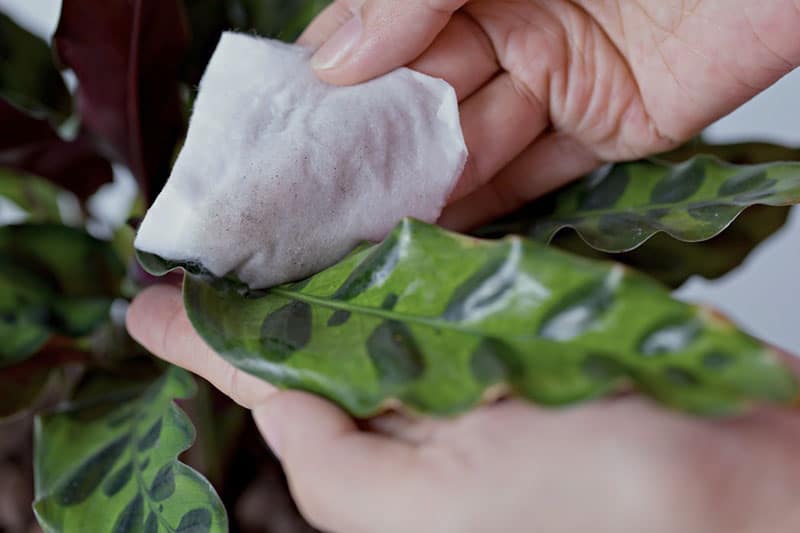
It’s a wise practice to regularly wipe down the leaves of your Calathea to keep them free of dust and any pests they may be harboring.
Once a month or so, you can also run water over your plant. Gently tip the pot to the side and run the leaves and stems under the faucet or pour it from a watering can to ensure that any unwanted visitors will flow down the sink and not into the soil.
Maintaining the leaves with Neem oil.
Neem oil has a residual effect that is perfect for spider mite prevention. Spraying the stems and upper and undersides of the leaves once a month should protect your Calathea from a spider mite invasion.
Maintaining a high humidity level.
Spider mites thrive in hot, dry environments, so providing your Calathea with plenty of humidity will both discourage the mites and benefit your plant.
Calatheas grow best in warm, humid conditions, so a good amount of humidity is a healthy win-win situation.
The Prayer plants like 50% to 60% humidity, so you can use a humidifier if you own one.
Grouping your plants together and setting them on top of pebbles in shallow trays of water is another way to boost humidity. Be sure to keep them from sitting in the water, though, or you will risk root rot.
Also read: Misting Calathea: Does It Improve Humidity?
Removing weeds from the soil
Weeds can pop up anywhere, including houseplant soil, especially if you’ve set your plants outside during the summer.
Check the soil periodically and remove any little weed seedlings you find because they can harbor pests and compete with your plant for soil nutrients.
Fertilizing the Calathea
Your plant will be more likely to survive spider mite damage if it is kept in top shape.
Calatheas can be fertilized with a balanced, all-purpose fertilizer, such as 15-15-15. Dilute it to half strength and fertilize every two weeks during the growing season.
